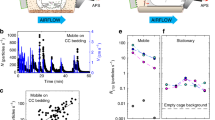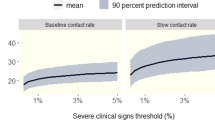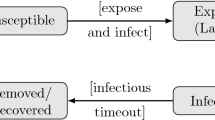Abstract
A Gaussian diffusion model was applied to an epizootic of pseudorabies in ten swine herds located in Decatur County, Indiana, USA to test the hypothesis that the virus can be spread via aerosol. The epizootic occurred during January to March, 1988, spreading through ten farms across an area of about 150 km2. The model included a receptor component that provided an estimate of viruses received by the pig within an enclosed barn. Results show that the diffusion model can explain the spread of the virus during the epizootic for all nine farms to which the virus spread.
Similar content being viewed by others
References
Chatigny MA, Dimmick RL, Harrington JB (1979) Deposition. In: Edmonds RL (ed) Aerobiology, a systems approach. Dowden, Hutchinson and Ross, Stroudsburg, Pa., pp 111–150
Christensen LS, Mortensen S, Bøtner A, Strandbygaard BS, Rønsholt L, Henriksen CA, Andersen JB (1993) Further evidence of long distance airborne transmission of Avjeszky's disease (pseudorabies) virus. Vet Rec 132:317–321
Donaldson AI, Wardley RC, Martin S et al. (1985) Experimental Aujeszky's disease in pigs: excretion, survival, and transmission of the virus. Vet Rec 113:490–494
Gifford FA (1968) An outline of theories of diffusion in the lower layers of the atmosphere. In: Slade DH (ed) Meteorology and atomic energy. USAEC, TID-24190, National Technical Information Service, U.S. Dept. of Commerce, Springfield VA, USA, pp 66–116
Gloster J, Sellers RF, Donaldson AI (1982) Long distance transport of foot and mouth disease virus over the sea. Vet Rec 110:47–52
Gloster J, Donaldson AI, Hough MN (1984) Analysis of a series of outbreaks of Avjeszky's disease in Yorkshire in 1981–82: the possibility of airborne disease spread. Vet Rec 114:234–239
Hanna SR, Briggs GA, Hosker RP Jr (1982) Handbook on atmospheric diffusion. DOE/TIC-11223, DE82-002045, National Technical Information Service, U.S. Dept. of Commerce, Springfield VA, USA
Hidy GM (1984) Aerosols an industrial and environmental science. Academic Press, pp 618–619, Orlando FL, USA
Huber AH (1991) Wind tunnel and Gaussian plume modeling of building wake dispersion. Atmos Environ 25A:1237–1249
Scheidt AB, Rueff MS, Grant RH, Teclaw RF, Hill MA, Meyer KB, Clark LK (1991) Epizootic of pseudorabies among ten swine herds. J Am Vet Med Assoc 199:725–730
Schoenbaum MA, Zimmerman JJ, Beran GW, Murphy DP (1990) Survival of pseudorabies virus in aerosol. Am J Vet Res 51:321–333
Wathes CM, Howard K, Jones CDR, Webster AJF (1984) The balance of airborne bacteria in calf houses. J Agric Enginrg Res 30:81–90
Author information
Authors and Affiliations
Rights and permissions
About this article
Cite this article
Grant, R.H., Scheidt, A.B. & Rueff, L.R. Aerosol transmission of a viable virus affecting swine: Explanation of an epizootic of pseudorabies. Int J Biometeorol 38, 33–39 (1994). https://doi.org/10.1007/BF01241802
Received:
Accepted:
Issue Date:
DOI: https://doi.org/10.1007/BF01241802




